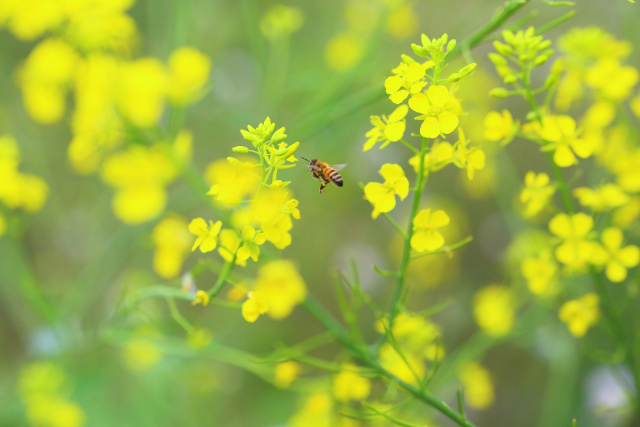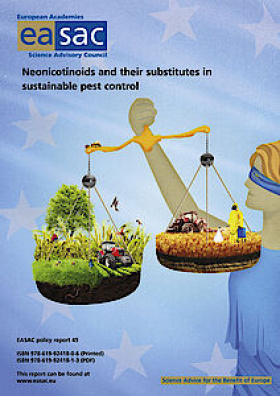EASAC’s New Report on Neonicotinoids presented at the Headquarters of the Hungarian Academy of Sciences
As a follow-up to its initial report on the subject in 2015, the European Academies Science Advisory Council (EASAC) has just published its second report on the agricultural use of the group of pesticides known as neonicotinoids. The public event presenting this latest report took place at the Hungarian Academy of Sciences on 29 March 2023. Should we allow the use of these substances in sustainable farming? Do they have anything to do with the loss of pollinators? Is there a role for this group of chemicals in Europe in the future? Here is a summary of the event which addressed all these questions, together with a link to the video recording.
Introduced in the 1980s and put on the EU market in 2005, neonicotinoids are chemicals that work by disrupting the functioning of the central nervous system of insects. Perhaps their most important feature is that their effect on arthropods is orders of magnitude stronger than on vertebrates, making them much safer to use than many other insecticides. At the same time, as neonicotinoids are capable of being absorbed by plants, they may appear anywhere from the roots to the pollen of plants. One of the most important uses of these chemicals is seed dressing, that is, the protection of seeds in the soil. After the germination of the seed, these substances penetrate the plant and then go on to enter the groundwater through soil erosion. This means they can end up contaminating areas further away from the place of their actual application, especially as they degrade relatively slowly.
Initial restrictions and the first report
These pesticides were widely suspected of contributing to a wave of honeybee losses across the globe, therefore the European Commission, apparently confident that it had sufficient evidence against the substances, decided in 2013 to introduce a ban on the outdoor (i.e. non-greenhouse) use of three of the five neonicotinoids then in use. It was in the wake of this measure that the European Commission called on the EASAC to prepare a comprehensive report on the environmental impact of these chemicals.
 Photo: istockphoto.com
Photo: istockphoto.comBeyond the initial concerns for honeybees, the report, which was completed in 2015, took a much broader perspective, highlighting the adverse effects of neonicotinoids. Interestingly, honeybees, which were initially the focus of attention, turned out to be less than ideal indicators of the impact of these pesticides: as these eusocial insects live in large colonies, their communities are capable of coping with the loss of a relatively high proportion of their members. Much more worrying are the effects on pollinators and other beneficial insects which live a solitary life or are confined to small groups, so the size (or lack of) of the community to which they belong may not provide a buffer. Solitary bees, bumblebees, predatory insects or other beneficial invertebrates of all kinds may be susceptible to these insecticides as non-target organisms; in other words, collateral damage is significant. In addition, there is evidence that even very low levels of neonicotinoids can have sub-lethal effects on invertebrates – that is, effects that do not kill them directly, but reduce their chances of survival.
The key message of the 2015 report was that the use of neonicotinoids, particularly for preventative purposes, is incompatible with biodiversity-based sustainable agriculture.
Additional bans and the second report
The ban on the use of neonicotinoids was maintained and even extended by the European Commission in the late 2010s, keeping four of the five substances introduced in the EU on the list of banned substances and lowering the allowed environmental presence thresholds for the fifth.
This might have been the end of the story for this group of chemicals, at least within the European Union, but things have taken a more complicated turn. The report, which came out this February, set out to identify the impact of restrictions on the use of neonicotinoids and the steps which still need to be taken.

The new report found that research since 2015 has confirmed and validated the wide-ranging effects of neonicotinoids on the ecosystem in general, and argues for the development of an agricultural system in the European Union that regards integrated pest management (IPM) as its main tool. This means that threats to crops should be prevented through the leveraging of favourable habitat characteristics, the selection of the most appropriate crop species, and the use of organic farming methods, with the use of chemical pesticides reserved only for specifically assessed, concrete risks.
The report addresses the widespread practice of farmers or Member States seeking emergency authorisations for the use of neonicotinoids for various reasons. It has been questioned whether an annual occurrence of the pest can reasonably be considered an “emergency” and whether its treatment through seed dressing can be regarded as an emergency measure.
Another concern identified by the authors of the report was that novel chemicals with similar modes of action have been developed which fall outside the scope of the bans that apply to the older, comparable substances, although they are likely to pose the same threat to non-target insects as the originally banned substances. The proposal put forward by the report is that new chemicals should be presumed to have adverse effects unless the manufacturer of the chemical concerned has provided evidence to the contrary.
The report was presented to the public on 29 March 2023 at the Hungarian Academy of Sciences, with lectures and a round table discussion on the agenda of the event. The recording of the session can be viewed here.
0:00 | Introduction – István Palugyai, science journalist, moderator of the event
2:02 | Greetings – György Kosztolányi, Vice-President of MTA
6:01 | The process of EASAC report preparation – Lars Walløe, Chair of EASAC’s Environment Steering Panel
16:59 | Presentation of the Neonics report – Mike Norton, EASAC’s Environment Programme Director
Invited comments by:
52:48 | Ervin Balázs, Member of MTA, Chair of MTA’s Section for Agricultural Sciences
1:06:13 | László Hornok, Member of MTA, Professor Emeritus at the Hungarian University of Agriculture and Life Sciences
1:17:10 | András Székács, Doctor of MTA, member of the Expert Group
1:28:20 | Round-table discussion, Q&A
2:08:25 | Wrap-up and closing of the session – Lars Walløe and György Kosztolányi
About the event
Co-organised by the Academia Europaea Budapest Knowledge Hub, the 29 March session was opened by MTA Vice-President György Kosztolányi and featured main contributors Lars Walløe, Chair of EASAC’s Environment Steering Panel, who gave a presentation about how the report was actually prepared, and Michael Norton, EASAC’s Environment Programme Director, who gave a detailed presentation on the content of the report itself.
The presentations were followed by invited comments from three experts: Ervin Balázs, Member of MTA, Chair of MTA’s Section for Agricultural Sciences; László Hornok, Member of MTA, Professor Emeritus at the Hungarian University of Agriculture and Life Sciences; and András Székács, Doctor of MTA, member of the working group that prepared the report.
After these comments, the audience was invited to put questions to the panellists in a round-table discussion. The session was concluded by short closing remarks from Lars Walløe and György Kosztolányi.
EASAC in brief
The European Academies’ Science Advisory Council (EASAC) was established by the national science academies of the EU Member States to provide independent, science-based advice to European policymakers. Through EASAC, the European science academies can take coordinated action and make their common voice heard in a wide range of policy debates. Established in 2001 at the Royal Swedish Academy of Sciences, EASAC also counts the Hungarian Academy of Sciences amongst its members.
